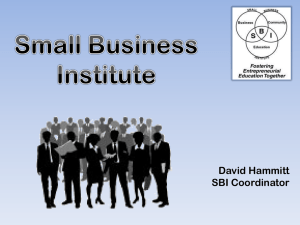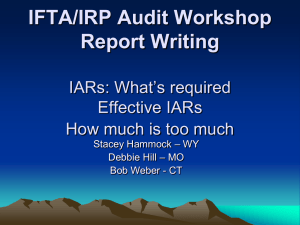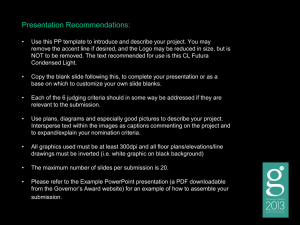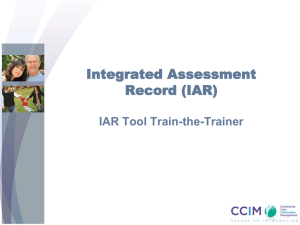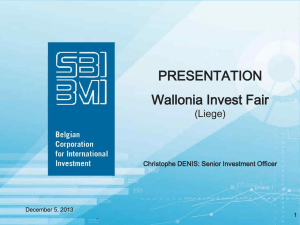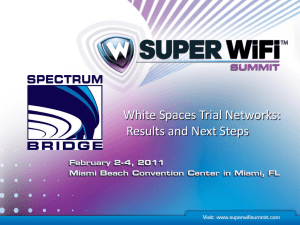Planning for the International Assessment and Review
advertisement
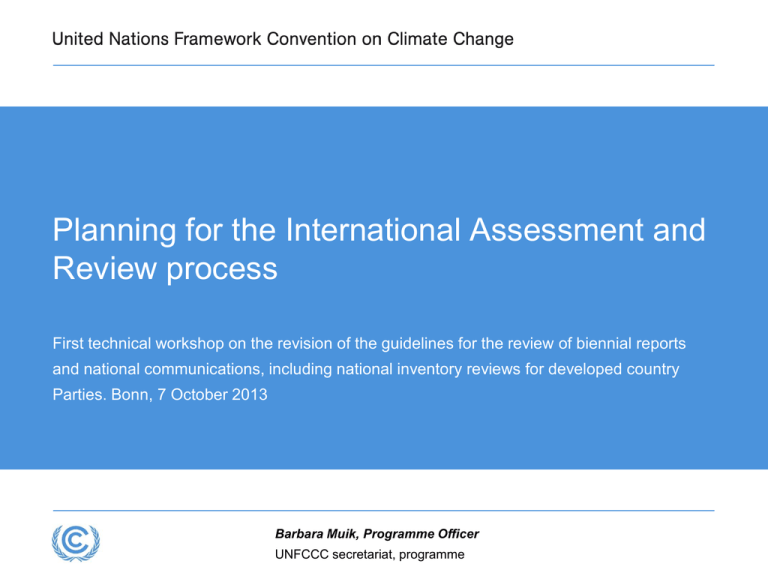
Planning for the International Assessment and Review process First technical workshop on the revision of the guidelines for the review of biennial reports and national communications, including national inventory reviews for developed country Parties. Bonn, 7 October 2013 Barbara Muik, Programme Officer UNFCCC secretariat, programme IAR cycle based on decision 2/CP.17 1st IAR cycle 1 January 2014 – submission of first biennial reports 1 March 2014 (two months after submission (para. 25)) – 1st round of IAR starts with the technical review of BRs: In accordance with existing and revised guidelines and procedures (para. 6, Annex II); Technical review report based on existing reporting standards (para. 7, Annex II); Multilateral Assessment builds on the published BR review report as major input (para. 8, Annex II); Any Party can submit written questions in advance of the MA (para. 10, Annex II); The Party under assessment should respond to those questions within two months (ibid.); The secretariat will compile the Q+As and publish them on the UNFCCC website (ibid.); IAR cycle based on decision 2/CP.17 1st IAR cycle During the SBI session, all AI Parties will undergo the assessment. IAR output record (para. 30, and para. 11 of Annex II): Secretariat to prepare a summary report of the SBI; Any other observations by the reviewed Party submitted two months after the SBI. Key steps and involvement: BR submission Party under IAR Other Parties ERT Secretariat Technical review Multilateral assessment IAR cycle based on decision 2/CP.17 Detailed 1st IAR cycle Technical Review (17 weeks) • [Preparation of review (4-8 weeks before RW)] • Review week (1 week) • Finalizing review report (16 weeks after review week) Multilateral Assessment (14 weeks) • Preparation of MA (min.12 weeks before SBI) • Questions by Parties (min. 4 weeks) • Answers by Parties (min. 8 weeks) • MA during SBI (2 weeks) IAR Party Record (9 weeks after SBI) • SBI summary report (9 weeks) • Observations by the reviewed Party (8 weeks after SBI) • Q+As by Parties • Review report IAR cycle based on decision 2/CP.17 Detailed 1st IAR cycle 1 March, beginning of 1st IAR Technical review (17 weeks) prep SBI (2 weeks) IAR Record (9 weeks) IAR process (40 weeks) 2014 1st BR and 6th NC submission Preparation IAR (12 weeks) 2015 2016 2nd BR submission IAR cycle based on decision 2/CP.17 Detailed 1st IAR cycle 1 March, beginning of 1st IAR RW 29 weeks before SBI RR 12 weeks before SBI Record 9 weeks after SBI IAR process 2015 2014 SBI 40 1st BR and 6th NC submission SBI 41 SBI 42 2016 SBI 43 2nd BR submission IAR cycle based on decision 2/CP.17 Detailed 1st IAR cycle 1 March, beginning of 1st IAR RW 29 weeks before SBI RR 12 weeks before SBI Record 9 weeks after SBI IAR process 2015 2014 SBI 40 1st BR and 6th NC submission SBI 41 SBI 42 2016 SBI 43 2nd BR submission IAR cycle based on decision 2/CP.17 Detailed 1st IAR cycle Record 9 weeks after SBI 1 March, beginning of 1st IAR RW 29 weeks before SBI RR 12 weeks before SBI IAR process 2015 2014 SBI 40 1st BR and 6th NC submission SBI 41 SBI 42 2016 SBI 43 2nd BR submission Planning for 1st IAR cycle – challenge – continuous review activities puts pressure on Parties and the secretariat Planning for 1st IAR cycle For the multilateral assessment of Parties working group session under SBI 41 (Dec 2014) Review week by April 2014 Review report by August 2014 IA record by Jan 2015 For the multilateral assessment of Parties at SBI 42 (June 2015) Review week by October 2014 Review report by February 2015 IA record by July 2015 For the multilateral assessment of Parties at SBI 43 (Dec 2015) A few remaining Parties, if needed. Planning for 1st IAR cycle – challenge - increasing demand for review experts Increasing number of experts is needed 144 experts in NC5 review cycle (in-country and centralized reviews) Pressure on AI Parties: Financial resources to fund experts; In-kind contribution by experts (15-20 working day per review/per expert) Organizational efforts for in-country reviews and mobilization of resources for reviews Enhancing competence of experts Competing review processes: annual and periodic (the same experts are involved in the review activities. Participation in both GHG inventory and BR/NC reviews in 2014 implies up to 40 working days away from the expert’s ordinary work. This hardly possible for many experts) Conclusions Continuous IAR activities in 2014 -2015 puts huge pressure on resources (time, people and financial) of Parties and the secretariat: Challenges due to: Launching of a new process Tight schedule for IAR The need for increasing number of experts; The need for qualified/trained experts. Need to consider these challenges while discussing format of the BR/NC reviews.
